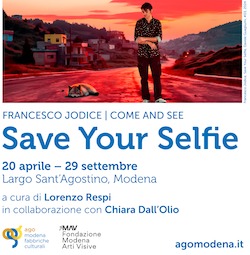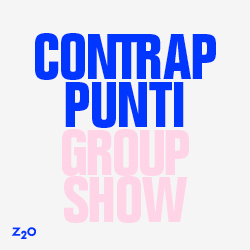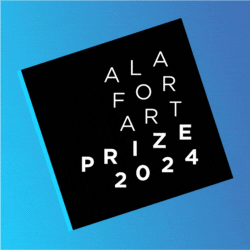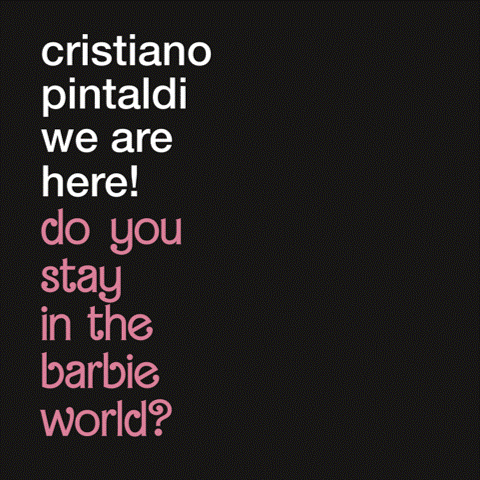[nemus_slider id=”70963″]
—
English text below
Nella sua mostra personale Surroundings – ospitata negli spazi di Renata Fabbri Arte Contemporanea fino al 20/01/2018 – l’artista croata Vlatka Horvat indaga la linea dell’orizzonte come potente e contraddittoria metafora; da una parte limite spaziale e confine, dall’altra meta a cui si aspira di giungere. Attraverso le opere realizzate con diverse forme e media – fotografie alterate, collage, sculture e fragili interventi ambientali – l’artista rende l’orizzonte confine liminare tra spazio e visibilità, segno o luogo di azioni in potenza future.
In occasione della presentazione di questo nuovo ciclo di opera, abbiamo intervistato l’arista.
ATP: Surroundings – il titolo della tua mostra – è una parola che nella traduzione in italiano, ha molti significati. Quello che mi affascina di più è quello legato al concetto di “area, portion”. Quale significato hai dato a questa parola e perché l’hai scelta?
Vlatka Horvat: Il termine ‘surroundings’ ha molte accezioni anche in inglese. Il primo significato che gli ho dato è quello di ‘cose che ci circondano’, che si riferisce sia al mondo esterno, alla natura, al paesaggio, che alle strutture e agli ambienti costruiti dagli uomini quali città, edifici, stanze, sistemi nei quali operiamo.
Ho voluto intitolare così la mostra anche per instillare nella nostra mente ciò che è al di là della descrizione di spazio fisico circostante, delle altre cose che ci circondano, che ci definiscono o addirittura ci intrappolano: il sistema, le strutture, i codici comportamentali, le memorie. Questi elementi sono sempre parte del contesto in cui viviamo e con il quale interagiamo. Il sistema e le strutture invisibili ci circondano allo stesso modo degli ambienti e del paesaggio.
Nel mio lavoro spesso indago i legami – fisici, materiali e anche concettuali – e porto avanti questioni come limiti, bordi, vincoli, le cose che ci contengono come esseri umani… è spazio fisico, paesaggio, è la società con i suoi codici e norme e pensando all’individuo è anche il nostro corpo, la nostra pelle. Il corpo è un altro contenitore, una cornice che adoperiamo come mediazione della nostra esperienza del mondo, un’altra “cosa” che ci attornia. Quando intitolo una mia opera, ciò a cui guardo spesso è proprio questo genere di termini “ombrello”, parole che hanno un significato, letterale, ma che possono anche mutare di senso in altri contesti, così che quando ne scelgo uno, forse ovvio e semplice, all’improvviso qualcosa complicherà la sua lettura.
ATP: Un altro concetto su chi ruota la mostra è l’ “orizzonte”. Luogo indefinibile, l’orizzonte è anche la linea dove si incontrano, idealmente, la terra e il cielo. Cosa ti ha attratto di questo confine?
VH: Mi piace come l’orizzonte sia un termine sia spaziale che manifestazione fisica di distanza (e paesaggio) – come tu affermi, un luogo dove la terra incontra il cielo (il materiale incontra l’immateriale?)- ed è anche un termine temporale. Come metafora, parla di distanza nello spazio fisico, ma anche del futuro (c’è qualcosa all’orizzonte).
Pensandolo in termini di distanza sia temporale che spaziale, l’orizzonte mi sembra connesso alla promessa di qualcosa, qualcosa che è lì, visibile, ma (solo) fuori dalla nostra portata. Quella genere di promessa di qualcosa di migliore del nostro immediato qui e ora, o qualcosa di peggiore, ma qualcosa di diverso da “questo”, di sconosciuto. Come segno cattura un sentimento di possibilità, ammiccando a ciò che potrebbe essere, esistere, succedere, che potrebbe anche solo essere possibile. Allo stesso tempo tutte queste cose sono irraggiungibili come promesse di questo “qualcos’altro/altrove/altro tempo”, che continua a muoversi come noi ci muoviamo – non è una cosa immobile, ma che è connessa a noi, che sembra sempre alla stessa distanza che però è incolmabile.
Su un livello più banale, mi piacerebbe pensare all’orizzonte come ad una linea, un disegno nello spazio che ci contestualizzi, aiuti ad orientarci, anche se si presenta solo come un punto finale della nostra visione. Ci dà la sensazione di infinito e finito al contempo, di tempo, di spazio e un chiaro limite: non possiamo vedere oltre.
ATP: Attraverso i tuo lavori hai espresso il significato di orizzonte mediante diversi media: fotografie, collage, sculture. Cosa motiva la scelta di un materiale rispetto ad un altro? Come li scegli in relazione ai contenuti?
VH: Spesso affronto le tematiche che mi attraggono, analizzandole con diversi media. I gesti stessi, o le idee o domande che si manifestano e si articolano mediante diversi media dipendono dalle possibilità degli stessi: è vocabolario, modus operandi, proprietà materiali, limite. Spesso ritorno sulle stesse immagini o argomenti attraverso lenti diverse, mi interessa il processo di riposizionamento, testare strumenti e materiali differenti per la stessa argomentazione… L’orizzonte è spuntato fuori molto nel mio lavoro! Ma la materialità di come si articolava in media diversi, condizionava totalmente come poteva essere letto: una linea dell’orizzonte creata da righelli rotti, tenuta insieme da elastici (come nel mio lavoro precedente Remade to Measure), oppure un orizzonte fatto di neon (come nel mio On Rising and Falling Ground), avrà una risonanza diversa, evocherà cose diverse rispetto ad uno fatto in modo rozzo, con stringhe intrecciate tra di loro, ad esempio. La scelta dei materiali e il modo in cui vengono usati, o pongono resistenza, contengono associazioni, evocazioni, significati.

ATP: Nella serie di collage che esponi, metti in relazione l’uomo con il paesaggio. Mediante tagli e sottrazioni, la presenza dell’uomo viene omessa a vantaggio della linea d’orizzonte. Quale senso dare a queste forme di negazione dell’uomo?
VH: Mi piace come dici “a vantaggio della linea dell’orizzonte”, perché penso all’orizzonte come soggettività che desidera. Penso sia vero che in questa serie il paesaggio in qualche modo abbia una rivincita. Usurpa lo spazio che prima era riservato alla figura umana. Performa questo scambio, segue la logica di riconnettere la linea che il corpo umano aveva interrotto. L’orizzonte si muove per riacquistare continuità. Ciò che accade alla figura in quel processo può essere visto come un danno collaterale…c’è certamente un certo livello di violenza nelle figure la cui testa viene ritagliata per espandere l’orizzonte, ma c’è anche ironia.
Le figure umane che posano per la macchina in un contesto naturale, ma senza testa o addirittura in posizioni ridicole, parlano di un’esperienza vera, ma inesprimibile: il senso di sentirsi perso nella natura, nel mondo, anzi di sentirsi sopraffatto dalla natura selvaggia, di perdersi in qualcosa che è più grande di noi. Possiamo approcciarci a questi collage per quello che rappresentano, per ciò che vediamo, ma c’è un altro strato che parla di invisibilità e che è implicito, meno preciso, che evade la nostra comprensione o abilità di tratteggiarlo in parole.
Quando stavo lavorando a questa serie, mi faceva ridere che l’idea dell’orizzonte o della distanza rappresentata da esso fosse qualcosa che si rifiutasse di essere di sfondo a queste immagini, si spostasse verso di noi e che volesse stare in primo piano… prendere il posto della figura, solo seguendo qualche facile regola della prospettiva! Spesso parlo di questo processo di spostamento dell’orizzonte in termini di linea del paesaggio che prende il sopravvento, richiede spazio a discapito dell’uomo, ma osservando bene l’immagine posso anche scorgere nuove interazioni tra uomo e natura. Le linee dell’orizzonte riconnesse si congiungono anche a porzioni di figure: il collo, i vestiti, le spalle. Possiamo dire che ciò che stiamo osservando è qualcosa che ha attaccato la persona, ha preso il sopravvento o immersa in una natura spersa, ma anche essere una presenza o forma ibrida tra umano e ambiente.
ATP: Hai tracciato una sorta di linea d’orizzonte all’interno della galleria con l’opera “At Some Lenght”. Il senso di quest’opera – fragile e provvisoria – è molto ambiguo proprio per la sua provvisorietà. Sembra che si stia per rompendo da un momento all’altro. Mi racconti com’è nato questo lavoro?
VH: Mi interessa dimostrare diverse cose con questo semplice e rude gesto sul muro. Da una parte è traccia del muro stesso, dall’altra è una sorta di conferma della solidità della barriera tra l’interno e l’esterno della galleria. Una parte rappresenta l’orizzonte, come linea di incontro tra terra e cielo. È anche metodo (un po’ avventato forse) per misurare la stanza, uno strumento fatto di frammenti di stoffa, tessuto, corda; poiché è pieno di nodi, c’è qualcosa di ruvido in esso, effimero, fragile nella sua materialità. I nodi mi fanno venire in mente il filo spinato, ma la linea orizzontale di per sé con o senza nodi è una sorta di recinto, il confine di uno spazio. Spesso mi muovo tra questi paradossi: come la linea che tratteggia il muro in molti modi conferma la solidità del muro e allo stesso tempo può essere vista come un gesto che taglia, una decisione immaginaria di lacerare la superficie, qualcosa che sfida e nega il muro, ma che ne rinforza la presenza. É un gesto di cancellazione, come a chiedere: “se questa cosa che è qui non ci fosse?”
ATP: Anche le sculture sono connotate da una forte instabilità. Gli interventi che compi negli oggetti, li rendono precari. Quale significato dai a queste manipolazioni?
VH: Spesso mi attraggono gli oggetti rotti o frammentati e spesso sono spinta a romperli se non lo sono! Frequentemente compongo e scompongo oggetti di tutti i giorni in qualcosa che non è più utilitaristico. Quindi non li rompo solo per lo spirito di farlo, ma ricerco modi per riorganizzarli spazialmente, combinarli o farli combaciare per creare qualcosa di nuovo da due cose che altrimenti non si incontrerebbero mai. Non mi interessa ripararli bene, ma applicare un’apparente catena di decisioni sbagliate. Uso spesso materiali che sono inadeguati per lo scopo (ad esempio le tavole che vengono riparate da pezzi di cartone attaccato con nastro adesivo), oppure adotto metodi che sono destinati a fallire perché non permanenti e di natura improvvisata, come ad esempio impilare o appoggiare oggetti su altri senza nulla che li tenga insieme, un metodo che li manterrà sempre in uno stato di precarietà.
ATP: Nella mostra Surroundings utilizzi la linea come “traccia esistenziale”. Mi spieghi il valore che le attribuisci?
VH: Non sono sicura di aver coniato io la frase “traccia esistenziale”, ma calza a pennello! Per me la linea ha questo stato di complessità in relazione alla presenza umana. La usiamo per marcare i luoghi, lasciare tracce, delineare il territorio, la nostra traiettoria, dare forma al nostro essere sulla terra. Per ogni cosa che facciamo, in ogni luogo in cui ci muoviamo lasciamo tracce, che siano visibili o meno.
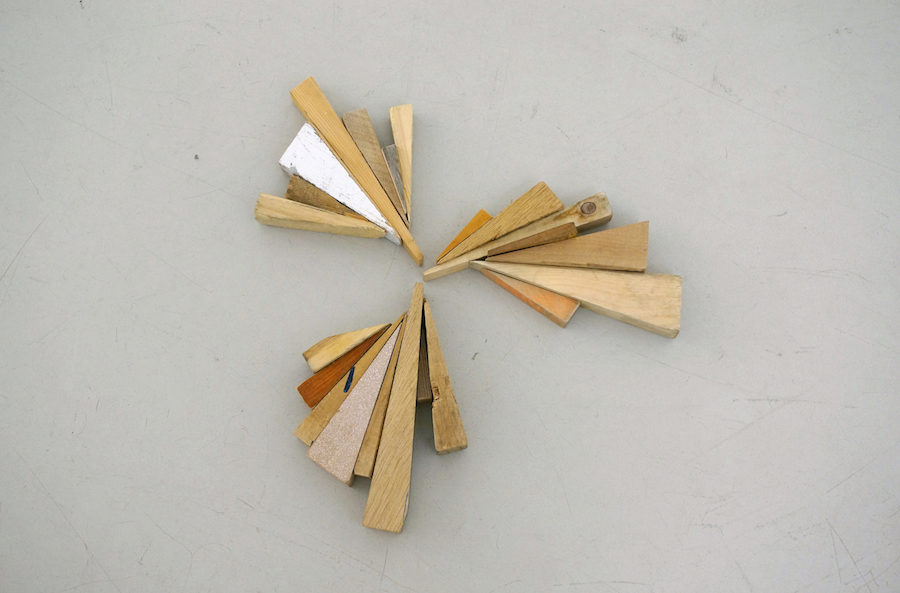
—
Interview with Vlatka Horvat
Surroundings
Renata Fabbri Arte Contemporanea, Milan
Until 20 January 2018
Renata Fabbri arte contemporanea presents Surroundings, Vlatka Horvat’s first show at the gallery, and her first solo exhibition in Italy.
In the show, which works across all of the gallery’s spaces, Vlatka Horvat approaches the idea of horizon line as spatial limit and border whilst at the same time exploring its powerful and contradictory metaphorical status as aspirational destination. In works manifested in different forms and media – altered photographic image, collage, sculpture, and fragile site-responsive material interventions – she renders the horizon as an edge of space and visibility, and as a sign or site of future potential and action.
ATP: Surroundings – the title of your exhibition – is an expression that, translated into Italian, has lots of meanings. One that fascinates me the most is related to the concept of “area, portion”. Which sense have you given to this word and why did you choose it?
Vlatka Horvat: The word ‘surroundings’ indeed has many meanings, in English as well. I was drawn to its immediate meaning as ‘things that surround us’ – which I take to refer to both the outside world – nature, landscape – and the built human-made environments and structures – cities, rooms, buildings – within which we move and act. But I wanted the title to also flag in our minds things that are beyond the descriptions of the physical space and physical environs, other things which surround us, and define us, and even trap us: systems, structures, codes of understanding, memories – these are all part of the contexts in which we exist and which we negotiate. Invisible structures and frames are as much “things that surround us” as the cities, or rooms, or natural landscapes.
In my work I’m often investigating constraints – physical, material, and conceptual alike – and pursuing questions of frames and borders and boundaries and limits, and the question of what are those different things that contain us as human beings… It’s physical space, it’s landscape, it’s society and its codes and norms, and on a level closer to an individual, it’s also our own body, our skin – the body as another container, another frame that mediates our experience of the world, another thing that surrounds us.
In titling my works I’m often looking for these kinds of double- or multi-faceted terms or phrases – words that mean one thing when taken literally but that also carry another meaning, so that you get one, perhaps obvious and deceptively simple, meaning right away and then something else that complicates your reading of it, or that opens things up in other directions.
ATP: Another concept around which the show has been conceived is that of the “horizon”. Indefinable place, it is also the line where, ideally, earth and sky meet each other. What about this boundary attracted you?
VH: I like how horizon is both a spatial term, a physical manifestation of distance (and landscape) – as you say, a place where the earth meets the sky (the grounded meets the immaterial?) – and it’s also a temporal term. As a metaphor, it speaks about distance in physical space as well as of the future (there’s something “on the horizon”). In terms of its status as a sign of distance – standing in for both spatial and temporal distance – horizon seems to me always related to the promise of something: something else over there, visible (just) but out of reach. A kind of a promise of something better than our immediate ‘here’ and ‘now’, or maybe not even better, but something ‘other than this’, something as yet unknown. As a sign it captures a sense of possibility by hinting at something that might be, that might exist, that might happen, that might just be possible. At the same time tho all those things are unattainable as the promise of this ‘something else’ / ‘somewhere else’ / ‘some other time’ keeps moving as we move – it’s not a steady thing, but something relative to us, always seemingly at the same distance from us – the unreachable distance.
And on a more banal level, I like to think of the horizon “just as a line” – a drawing in space, which frames us, which helps us get oriented – even if it just provides a kind of an endpoint for our vision. It gives at the same time a sense of endlessness and infinity – of space, of time ahead – and a clear limit: it’s as far as we can see and not further.
ATP: In your artworks, you have approached the horizon via different media: altered photographic image, collage, sculpture. What motivates you to choose one material instead of the other? Do you select them depending on their content?
VH: I’m often approaching some of the same questions via different media. And how a set of gestures, or ideas, or questions gets manifested or articulated in different media is absolutely dependent on the possibilities of that media: its vocabulary, its modus operandi, its material properties, its limitations. I’m frequently returning to some of the same images or tropes at different times and via different lenses – I’m interested in this process of repositioning, of testing different tools and materiality in relation to the same set of preoccupations… Horizon has been popping up in different guises in my work for some time! But the materiality of its articulation in different media absolutely affects how it can be read: a horizon line created with broken rulers held together with rubber bands, as in my previous work titled Remade to Measure, or a horizon rendered in neon, as in my On Rising and Falling Ground, will both have very different resonances, evoke different things – than a makeshift horizon line made of crudely knotted together bits of string. The choice of material, as well as mode of making that that material allows (or resists!), all carry with them their own associations, evocations, meanings…
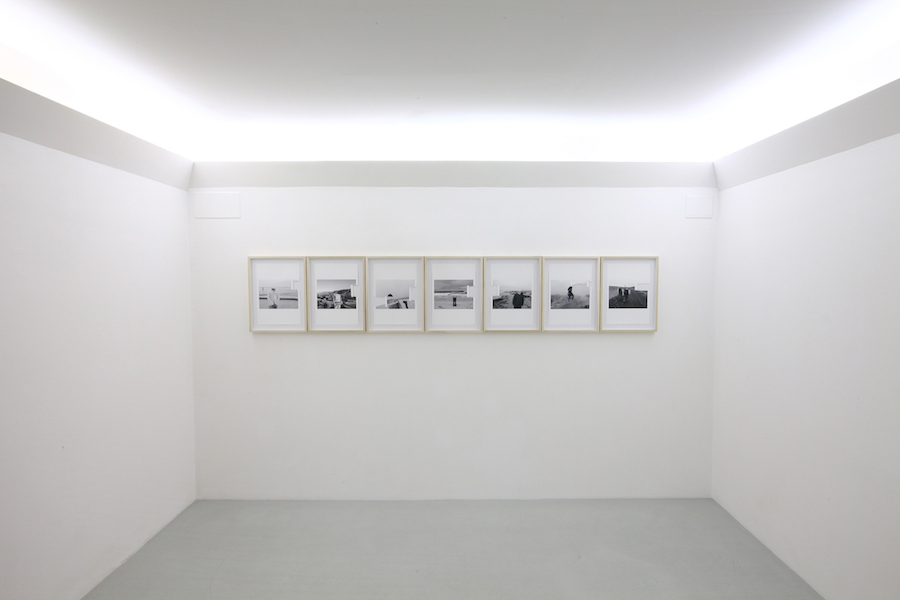
ATP: In the collage series End in Sight, which you are showing at the gallery, you evidently put in relation the human being with the landscape and the space. By cutting and “removing”, the presence of the human being is gradually being omitted in order to “benefit” the horizon’s line. Which sense have you given to this form of human denial?
VH: I like how you say “in order to benefit the horizon line” – as though the horizon here has subjectivity, wants things. I think it’s true that what is happening in this series is that the landscape somehow takes over. It usurps the space that was previously reserved for and occupied by the head of the figure standing in an outdoors setting – it performs this shifty move, following the logic of connecting the lines that the human figure has interrupted. So the horizon is moved so as to have continuity again. What happens to the figure in that process can be seen as a rather unfortunate collateral damage… there’s certainly a kind of violence in humans losing their heads at the expense of the horizon, but there’s also humour in it. The human figures posing for the camera in natural landscapes without their heads on is a rather ridiculous sight – but one that speaks to some real, if unexpressable experiences: the sense of being lost in nature, and in the world, the sense of being overwhelmed by nature, by the landscape, the sense of losing ourselves to something that is beyond us.
So again, we can look at these collages in terms of what they depict, what is visible in them, but there’s another layer maybe that speaks to something invisible, something implied, something more imprecise, which evades our understanding and our / my ability to depict it in an image or describe it in words.
When I was working on this series it was making me laugh to think that the horizon, or the distance as represented by the horizon, is somehow refusing to be the background in these images; it keeps moving to the foreground – and in order to become the foreground, it pretty much has to take place of the figure. It’s only following simple rules of perspective! I tend to talk about this procedure of moving the horizon in terms of the lines of landscape taking over, claiming space at the expense of the human, but looking closely at the images I can also see them as newly created mergers of the human figure and the landscape. The lines of the horizon connect to one another, but they also connect in places to the lines that outline or make the figures – their necklines, their clothing, their shoulders. So we can say that what we are looking at is nature which has taken over the person, or that we are looking at humans overwhelmed or immersed or lost in nature, or else, or also, that we are looking at something – hybrid forms, presences – that are part human, part environment.
ATP: In the work “At Some Length”, you basically traced a line along the wall of the gallery. The sense of this piece – fragile and temporary – has a certain ambiguity because of its temporariness. It seems it’s going to break at any moment. Could you explain how you conceived it?
VH: I was interested in several things with this simple and crude gesture on the wall: on the one hand it’s a trace of the wall itself, a kind of a confirmation of the solidity of the barrier between the interior of the gallery and the outside. On the other hand it’s a representation of a horizon line, a kind of a crude drawing of that place where the earth and the sky meet. It’s also a (foolhardy perhaps!) method to take a measure of the room – a kind of a measuring device hacked together by bits and cutoffs of string, rope and elastic. And because it’s full of knots, there’s a roughness to it – however ephemeral and fragile its materiality. The knots make me think of barbed wire – but the line itself, any horizontal line perhaps, knots of not – is a fence of sorts, an indication of a border, the edge of the space. I’m often drawn to these kinds of paradoxes: as the line traces the wall, in many ways it’s “confirming” the wall and its solidity, and at the same time it can be seen as performing a kind of a cutting gesture, an imaginary incision or a laceration on the surface of the wall, something that denies or challenges the wall at the same time as making its presence strongly felt. It’s a kind of a cancelling gesture, as if asking ‘and this which is here, what if that’s not here.’
ATP: The sculptures, two pieces titled Set Right, are themselves characterized by a strong sense of instability. The interventions you carry out in your objects makes them really precarious. Which meaning do you give to these manipulations?
VH: I’m often drawn to broken or partial objects and object parts and also drawn to taking them apart if they aren’t broken! Frequently I’m playing with reframing and reimagining everyday objects as something other than what we know them to be as utilitarian objects. So I’m not only taking them apart for the sake of fragmenting them, but am looking for ways to either re-organize them spatially, or combine or merge them with other fragmented objects, materials, or images in order to create something new through this meeting of two often unlikely things. I’m not interested in “proper” repair jobs tho, but rather in applying what might seem like a misguided set of decisions to the process: using materials that are clearly inadequate for the job at hand (in the case of the two sculptures you mention, the wooden tables are “repaired” using flimsy strips of cardboard, and attached to the tables with simple electrical tape), or else using methods that are doomed to fail because of their impermanence and improvisatory nature, such as stacking or leaning or balancing objects on top of other objects with no adhesives and no hardware – a method that puts them in a state of more or less constant precariousness.
ATP: In Surroundings, you use the line as an “existential trace”. What do you mean with this expression?
VH: I’m not sure I coined the phrase ‘existential trace’ but I can get on board with it! For me the line seems to have this complex status in relation to human presence: we use lines to mark places, to leave traces, to mark out territories, journeys, trajectories, to give shape to our being in the world. And everything we do, everywhere we move, we leave traces – visible and invisible ones alike.





